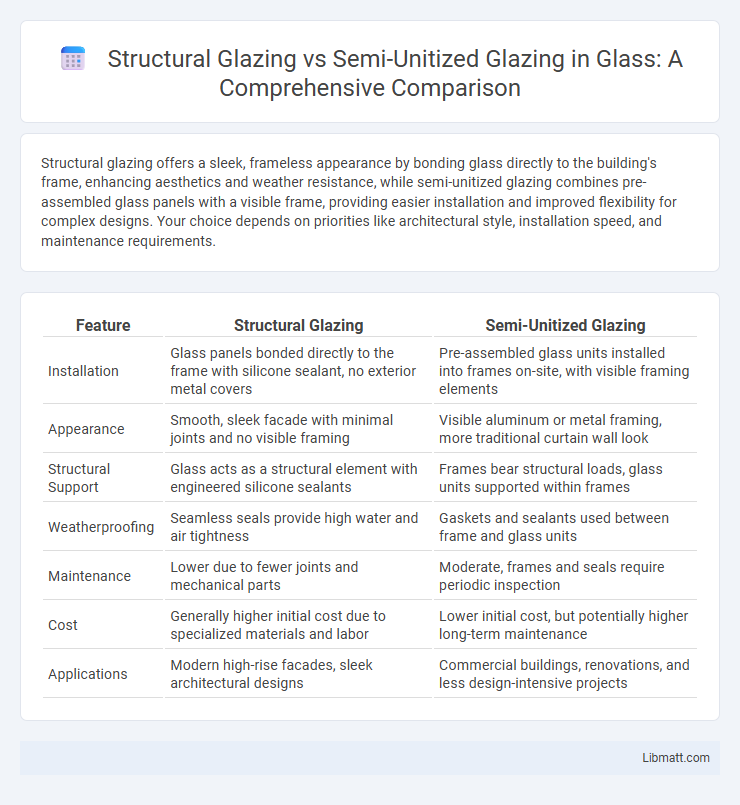Structural glazing offers a sleek, frameless appearance by bonding glass directly to the building's frame, enhancing aesthetics and weather resistance, while semi-unitized glazing combines pre-assembled glass panels with a visible frame, providing easier installation and improved flexibility for complex designs. Your choice depends on priorities like architectural style, installation speed, and maintenance requirements.
Table of Comparison
| Feature | Structural Glazing | Semi-Unitized Glazing |
|---|---|---|
| Installation | Glass panels bonded directly to the frame with silicone sealant, no exterior metal covers | Pre-assembled glass units installed into frames on-site, with visible framing elements |
| Appearance | Smooth, sleek facade with minimal joints and no visible framing | Visible aluminum or metal framing, more traditional curtain wall look |
| Structural Support | Glass acts as a structural element with engineered silicone sealants | Frames bear structural loads, glass units supported within frames |
| Weatherproofing | Seamless seals provide high water and air tightness | Gaskets and sealants used between frame and glass units |
| Maintenance | Lower due to fewer joints and mechanical parts | Moderate, frames and seals require periodic inspection |
| Cost | Generally higher initial cost due to specialized materials and labor | Lower initial cost, but potentially higher long-term maintenance |
| Applications | Modern high-rise facades, sleek architectural designs | Commercial buildings, renovations, and less design-intensive projects |
Introduction to Glazing Systems
Structural glazing involves the use of silicone sealants to attach glass directly to a building's frame, creating a sleek and seamless facade without visible metal frames. Semi-unitized glazing combines prefabricated glass panels and aluminum framing, allowing faster installation while maintaining structural integrity. Your choice between these glazing systems impacts aesthetics, installation time, and overall building performance.
What is Structural Glazing?
Structural glazing is a curtain wall system where glass is directly bonded to the building's structural elements using high-strength silicone sealants, eliminating the need for visible frames on the exterior. This technique provides a sleek, uninterrupted glass facade that enhances natural light entry and modern aesthetic appeal. Compared to semi-unitized glazing, structural glazing offers superior weather resistance and a higher degree of architectural flexibility.
What is Semi-Unitized Glazing?
Semi-unitized glazing is a curtain wall system that combines prefabricated panel units with site-installed components, offering enhanced flexibility and faster installation compared to fully unitized systems. It integrates framing and glazing elements partially assembled in the factory, reducing on-site labor and improving quality control. This method suits projects requiring customized panel sizes and complex architectural designs while maintaining efficient construction timelines.
Design Differences: Structural vs Semi-Unitized Glazing
Structural glazing features a fully glazed facade where glass panels are directly bonded to the building's frame using silicone sealants, creating a seamless, flush appearance with minimal visible framing. Semi-unitized glazing combines prefabricated glass modules with partial framing elements, allowing easier installation and better control over insulation and airtightness while maintaining a balance between aesthetics and structural support. The design of structural glazing emphasizes transparency and sleekness, whereas semi-unitized glazing offers modular flexibility and enhanced thermal performance through integrated frame components.
Installation Methods Compared
Structural glazing utilizes a silicone sealant to attach glass directly to the building frame, creating a sleek, uninterrupted facade with concealed fasteners. Semi-unitized glazing combines prefabricated glass panels with aluminum framing, which are assembled off-site and installed as larger sections, reducing on-site labor and installation time. Your choice between these methods influences project speed, weather tightness, and aesthetic outcomes based on building design and budget constraints.
Performance and Durability
Structural glazing offers superior performance with enhanced airtightness and weather resistance due to its flush, frameless design that eliminates visible exterior frames, resulting in a sleek facade and improved thermal insulation. Semi-unitized glazing balances performance and maintenance by combining factory-assembled panels with on-site installation, providing easier repairs and better adaptability to building movement while maintaining durability under varying environmental conditions. Your choice depends on whether you prioritize the seamless aesthetics and airtight performance of structural glazing or the flexibility and maintenance advantages of semi-unitized systems.
Aesthetic Impact and Flexibility
Structural glazing offers a sleek, seamless aesthetic by concealing framing systems behind the glass, enhancing the building's modern appearance with uninterrupted glass facades. Semi-unitized glazing provides greater flexibility in design and installation, allowing for pre-assembled panels that accommodate complex geometries and faster construction times. Your choice between these systems will influence both the visual impact and adaptability of the building envelope.
Cost Analysis: Structural vs Semi-Unitized
Structural glazing typically involves higher upfront costs due to its complex installation and specialized materials, which provide a sleek, seamless exterior appearance. Semi-unitized glazing offers a more cost-effective solution by prefabricating larger panels offsite, reducing labor expenses and installation time while maintaining thermal performance. Your choice between structural and semi-unitized glazing should consider both budget constraints and long-term maintenance savings.
Suitability for Different Building Types
Structural glazing is ideal for high-rise commercial buildings requiring sleek, uninterrupted glass facades due to its ability to bear structural loads without visible framing. Semi-unitized glazing suits mid-rise and low-rise buildings where partial off-site fabrication accelerates installation while offering flexibility for complex architectural designs. Your choice depends on project scale, aesthetic goals, and construction timelines.
Choosing the Right Glazing System
Choosing the right glazing system depends on your project's aesthetic, budget, and structural requirements, with structural glazing offering a sleek, frameless exterior ideal for modern facades but typically at a higher cost and complex installation. Semi-unitized glazing balances cost-efficiency and speed by using pre-assembled panels that combine framing and glazing, providing easier maintenance and better thermal performance for large-scale buildings. Evaluating factors such as installation time, building height, wind load, and long-term maintenance helps determine whether structural glazing's seamless look or semi-unitized glazing's practical modularity best suits your design goals.
Structural glazing vs semi-unitized glazing Infographic

 libmatt.com
libmatt.com